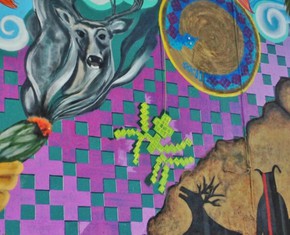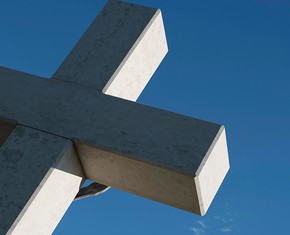The views expressed in our content reflect individual perspectives and do not represent the authoritative views of the Baha'i Faith.
For centuries scholars, theologians and clerics have tried to understand the enigmatic and cryptic prophecies in the Bible’s Book of Revelation.
As just one example, Chapter 20 of the Book of Revelation opens with a mysterious reference to the bottomless pit: “And I saw an angel come down from heaven, having the key of the bottomless pit and a great chain in his hand.” – Revelation 20:1.
In the Baha’i teachings, Abdu’l-Baha interpreted a similar passage this way:
“The beast that ascendeth out of the bottomless pit shall make war against them, and shall overcome them, and kill them.” [Rev. 11:7.] By this beast is meant the Umayyads, who assailed these witnesses [Muhammad and Ali] from the pit of error. And indeed it came to pass that the Umayyads assailed the religion of Muḥammad and the truth of Alí, which consist in the love of God. – Abdu’l-Baha, Some Answered Questions, newly revised edition, p. 59.
So Abdu’l-Baha interprets the “bottomless pit” as the “pit of error.” From the “pit of error” the Book of Revelation says the primordial “dragon, that old serpent, which is the Devil, and Satan” “must be loosed a little season.” – Revelation 20:2–3.
Here, reference to “the thousand years” in Revelation 20:3 refers to the previous religious dispensation, the Islamic era, prior to the advent of the Bab and Baha’u’llah, referred to in the following verse: “And I saw thrones, and they [the Bab and Baha’u’llah] sat upon them, and judgment was given unto them.” – Revelation 20:4.
Then: “the souls of them that were beheaded for the witness of Jesus, and for the word of God … lived and reigned with Christ a thousand years.” – Revelation 20:4. Here, “Jesus” refers to the end-time return of Jesus in the advent of the Bab; the “word of God” refers to Baha’u’llah; and the “thousand years” refers to the prophesied length of their religious Dispensation.
After the advent of the Bab and Baha’u’llah and the initial persecution of their followers, the Book of Revelation foretells in this well-known passage:
Satan shall be loosed out of his prison, And shall go out to deceive the nations which are in the four quarters of the earth, Gog, and Magog, to gather them together to battle. – Revelation 20:7–8.
Abdu’l-Baha defines that ensuing battle as:
… a spiritual war, meaning that the beast would act in complete opposition to the teachings, conduct, and character of these two witnesses … – Some Answered Questions, newly revised edition, p. 59.
Although this definition comes from Abdu’l-Baha’s explanation of Chapters 11 and 12 in the Book of Revelation, which he interpreted as being about the Islamic era, the very same principle applies to Chapter 20, which describes the Baha’i era. The “fire” that “came down from God out of heaven, and devoured them” (Rev. 20:9) refers to spiritual power and influence.
The second literary unit of Revelation 20 centers on the vision of the judgment of the dead. The Baha’i writings interpret “judgment” in prophecy as follows:
This judgment of God, as viewed by those who have recognized Baha’u’llah as His Mouthpiece and His greatest Messenger on earth, is both a retributory calamity and an act of holy and supreme discipline. It is at once a visitation from God and a cleansing process for all mankind. Its fires punish the perversity of the human race, and weld its component parts into one organic, indivisible, world-embracing community. Mankind, in these fateful years, which at once signalize the passing of the first century of the Baha’i Era and proclaim the opening of a new one, is, as ordained by Him Who is both the Judge and the Redeemer of the human race, being simultaneously called upon to give account of its past actions, and is being purged and prepared for its future mission. – Shoghi Effendi, The Promised Day Is Come, pp. 4–5.
In verse 11 of Revelation 20, a majestic prophetic scene opens this way:
And I saw a great white throne, and him that sat on it, from whose face the earth and the heaven fled away; and there was found no place for them.
Abdul-Baha interpreted the “great white throne” as follows:
Concerning thy vision of the angels surrounding the great white throne: This “throne” is the body of the Greatest name. The beautiful and glorious person riding upon the white horse is the Greatest Name [Baha’u’llah] …. Be thankful for this great favor. – Abdu’l-Baha, Tablets of Abdu’l-Baha Abbas, p. 681.
In the same way the Baha’i teachings point out that the “sea” (Revelation 20:13) is a common scriptural symbol of multitudes and of the totality of existence, and “the dead” (Revelation 20:12–13) refers to “the spiritually dead.”
The “second death” mentioned in Revelation describes spiritual death, rather than physical death, which is as constant a law of the physical universe as is gravity. No matter how much we might wish that somehow physical immortality might be possible, it is quite impossible, even though some Christians and Muslims who interpret the Bible and the Qur’an literally generally believe otherwise in looking forward to a physical resurrection. Since death is a fact of life, there is no choice but to accept the inevitability of physical death. That said, our attention should shift to the quality of the afterlife, which is greatly conditioned by the spiritual quality of our earthly life.
What is true for the individual is also true for humanity as a whole. Prophecy, like that contained in the Book of Revelation, concerns the future of the world following the “end of history.” Baha’is understand the Judgment Day, although occurring at the “time of the end,” as really a new beginning in human history—the threshold of a new era that will, in the course of time, lead to a golden age of humanity. This glorious destiny of human civilization represents the inevitable social and spiritual evolution of society, for which the powerful socio-moral and spiritual principles of Baha’u’llah serve as a potent and dynamic catalyst.
Revelation 20 doubtless had a contemporary meaning for early Christians suffering intense persecution in the Roman era. As such, the meaning and message of Revelation 20 is both specific to a historical time and place (i.e. events in early Christianity), and archetypal, paradigmatic, mythic, with an immediate and vivid relevance to our day and age.
The time of the end represents a new beginning.
Revelation 20 is not a crystal ball in which we can gaze to see an actual portrayal of future events. It’s not like watching a YouTube video online. The vision is hazy.
Instead, the scenario that Revelation 20 depicts is a symbolic paradigm of prophetic advent, followed by persecution, to be triumphantly overcome. Good over evil— a recurring theme re-enacted time and again, from age to age.
This cosmic drama was replayed, with a recurring pattern of cosmic conflict occurring under new circumstances in the nineteenth-century Middle East. Same scenario, under new and different facts.
One way for Satan to be defeated is to expose him for what he really is: a symbolic personification of human evil and perversity. As Walt Kelly captioned in the famous “Pogo” cartoon strip, “We have met the enemy and he is us,” we are just as intensively engaged in dealing with a global social environmental crisis as we are dealing with a world-wide physical environmental crisis.
The Bab and Baha’u’llah fit the prophetic end-times scenario foreseen and foretold in Revelation 20. These two prophetic-founders of the Baha’i Faith universalized Revelation 20 by equipping and empowering humanity with powerful spiritual, moral and social principles — our “weapons” for subduing “Satan,” once and for all time.
















Comments
Sign in or create an account
Continue with Googleor